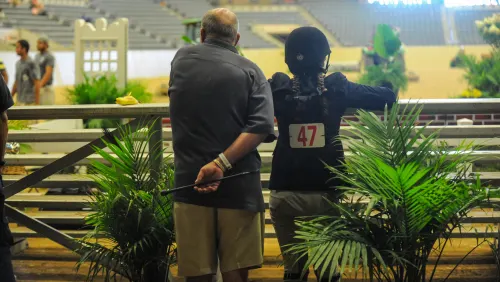Back in mid-October, in our weekly website survey, we asked readers whether they thought equitation was still relevant, and 51 percent basically said no, that equitation was just posing or a showcase for expensive horses that had become a useless end in itself. Said one reader, “Equitation is learning how to look pretty on an expensive horse. It’s not learning how to ride.”
That prompted Deloise Noble-Strong, who teaches riding to students of Garrison-Forest School in Maryland and takes them to AA-rated shows, to write a rather forceful letter we published last week (“Equitation Is Key.” Nov. 18, p. 138). Since her letter raised some profound points, and since she’d taken us to task for promoting the viewpoint that equitation wasn’t relevant, I gave her a call. She called me back from a show in Raleigh, N.C., and I met an instructor who’s committed to teaching kids all about riding and horses. She requires them to groom, feed, muck out and be responsible for the horses they ride, because her goal is to teach them how to actually ride and to develop horses, not just win ribbons.
Noble-Strong sees equitation as much more than just learning to ride in the proper position or showing in classes called “equitation” instead of “hunter” or “jumper”–or even eventing or dressage. “Your horse goes well when you ride him well, and if you’ve developed those skills, you can ride any horse well. All together, it’s part of horsemanship,” she said.
ADVERTISEMENT
I suggested to her that two related cultural factors are exerting a harmful effect on horsemanship and equitation. The first is there’s hardly an off-season anymore, especially in hunter/jumper shows. So students spend less time at home learning how to ride, developing their horses, or pushing their skills to the next level. Often, trainers are just preparing their students for the next show. Second, today’s barn business model tends to be more factory based–get as many horses to the shows (or to be sold) as quickly as possible. So some trainers actually (even strongly) discourage their students (kids or adults) from doing anything but riding at the barn, all in the name of efficiency. “I think there’s a lot more to horses than that,” said Noble-Strong.
She told me that both responses result from the pressure so many trainers feel to produce results (ribbons) for the money their customers are spending. But she believes that students should expect to be fully involved with their horses. “I think there’s a way to change the mindset,” she insisted. “If you give kids a goal or a standard, they’ll respond to it. If they really want to show, they should do the work. And they shouldn’t expect a horse to be perfect at the show if they haven’t done the work before they get there.”
In her letter, Noble-Strong suggested that we at the Chronicle have a responsibility to re-educate our readers about equitation, so I asked her how? She said that junior riders from all around the country read about, or see in action, an elite group who are the most successful in the big equitation classes, a group that often has equitation horses, hunters and jumpers. So we should show them they don’t need three horses. “They think they have to have a horse for each division, and that tends to make any kind of riding appear to be more exclusive and unavailable, and that doesn’t have to be the case,” she said. “I don’t want kids to believe that because they have a children’s hunter they can’t ride in equitation classes.”














